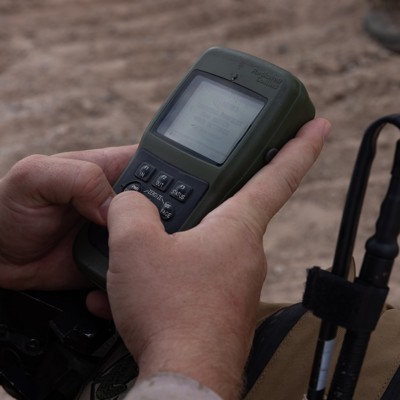Quantum devices that measure Earth’s magnetic fields could help replace GPS—if researchers can figure out how to tell when such devices are working well, or even at all. A Pentagon contract suggests one company is solving that key problem.
On Tuesday, SandboxAQ announced an agreement with the Defense Innovation Unit to join the Transition of Quantum Sensing program, or TQS, which allows the military to test the company’s AQNav software aboard a range of aircraft under a variety of conditions, according to a release viewed exclusively by Defense One. The deal builds on the company’s previous agreement with the Air Force, which tested the company’s software on C-17 Globemaster IIIs during exercises in May and July 2023.
Luca Ferrara, general manager of AQNav at SandboxAQ, said the agreement, coupled with recent research breakthroughs, has set the stage for rapid development in magnetic navigation. It will still take years before small, cheap, self-piloting one-way attack drones are able to find their way to targets, he said, but the DIU contract shows confidence that researchers are now asking the right questions.
Magnetic sensing is not exactly new. A patchwork of magnetic fields across the Earth’s crust is what makes a compass point north. But “north” doesn’t offer the level of precision a commander would want to chart a course for a plane or a drone.
High-tech and expensive quantum sensors can pick up information about magnetic fields far more accurately than old compasses. But the variation in those magnetic fields across the Earth’s crust, the very feature that makes them useful as a location tool, also means that quantum sensors will work well in some places and not in others. Maps that show different magnetic fields are limited, and the testing of magnetic sensors is similarly constrained.
“The way those maps get made at scale is, you have a plane that’s specially outfitted with a lot of sensors. You can get down to like tens of meters of accuracy … That’s what we would call a very well-sampled map, and you have a very clean signal, meaning your magnetometer is in a clean part of the plane,” Ferrara said. In other words, it works well under scripted conditions.
To make magnetic navigation useful where GPS is under attack, researchi is building out an understanding of how it will or will not work under a much wider set of conditions.
But that is a huge challenge, since the standard metrics that researchers use to certify navigation performance, like Required Navigation Performance or the U.S. military’s Circular Error Probable, can be misleading when dealing with magnetic navigation. A lot of what the company does is employ AI to figure out how to fill in those gaps.
A paper by SandboxAQ’s chief navigation engineer, Prasenjit Sengupta, in the December 2025 scientific journal Navigation, discusses a new method to compute the degree to which the error rate stays within certain knowable bounds. It’s a bit like a weather report to tell you how clear or cloudy it is outside, but instead it offers a reliable statistic to indicate how “cloudy” your magnetically sensed position is.
Magnetic navigation isn’t going to be a perfect replacement for GPS, Ferrara said. But if you can understand the conditions under which it will perform better or worse and to what degree—or, as he described it, “Knowing what the limitations are and working around them with the user”—then you have at least some of the essential building blocks to decide what other positioning systems to include in a GPS-backup scheme.
“Just to be clear, it’s also about having the sensors on board that platform be able to reliably, scalably create clean measurements so that it can know where it is in the moment reliably and well, to the best of our ability, every time,” he said, underscoring that even a GPS alternative has to know its own limits.
Read the full article here








Leave a Reply